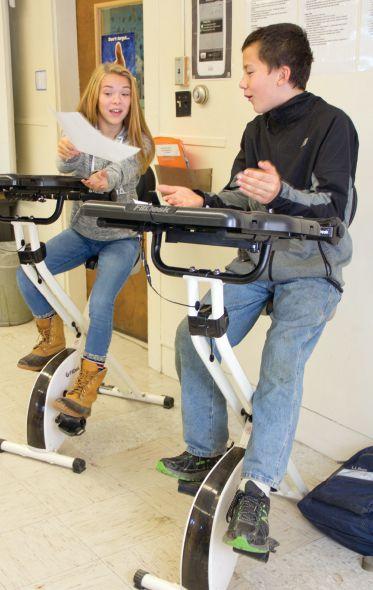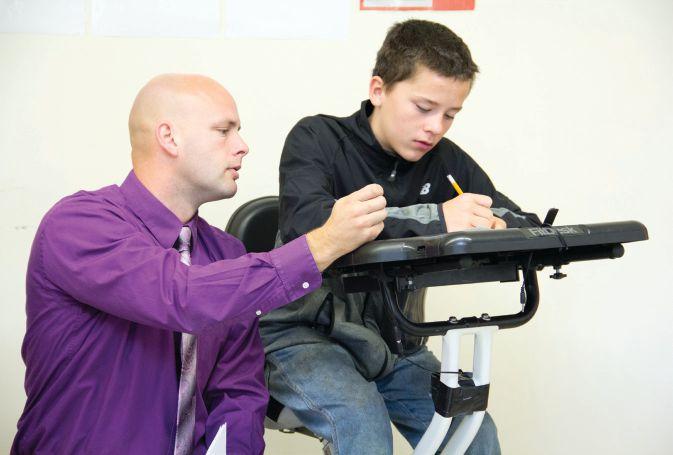
3 minute read
Math and Movement
on a bicycle built for one
There is a quiet, but constant hum coming from the corner of Josh Lambert’s math class at China Middle School. It’s almost so quiet you can’t hear it—but if you look in the corner of the room you know exactly where it’s coming from. Two students are continually pedaling away on stationary bike desks—moving and answering math problems at the same time. “I had the idea before I knew bike desks existed. We have 80-minute math classes—it's a long time for kids to sit and listen to adults; I wanted some way to get them to move,” said Lambert, RSU 18 EA. That’s when this energetic teacher approached his principal with the bike desk idea, wondering if they were a real thing in hopes of keeping his students motivated and engaged for the duration of his class. Shortly after, the simple discussion of “does something like a bike desk exist?” Lambert said he had a catalogue in his hands with exactly what he was looking for.
“It's a pretty inexpensive solution—it was no epiphany, really. I just wanted some way for the kids to be active in the classroom,” said Lambert.
The extra activity appears to be working. “I’m energized when I’m on the bike. I have morning math classes and I'm very tired, but this keeps me awake and it makes me really focus on my work rather than slumping in a chair. When I'm on this I'm really ready to work,” said 8th grader Morgan Presby.
Since this is the fi rst full school year with the bikes in the classroom, Lambert doesn’t have any hard data to show if the movement is improving test scores or overall math performance, but he can say with certainty the pedaling is making a diff erence in the overall concentration of his students.
“Individually on a day-to-day basis it helps, absolutely. It takes out that nervous energy, and that little bit of motion is all it's going to take,” said Lambert.
The school bought the cycle desks through a “Lets Go!” program grant from Inland Hospital in Waterville. Each desk, purchased from the company FitDesk cost $375.
Lambert says the inexpensive solution to keep kids motivated has turned out better than expected. Students have no problem taking turns on the bikes and even get excited at the idea of how far they’re pedaling while working.
“We got to travel all the way to Virginia,” said Morgan. While physical fi tness was never the main goal of the bike desk it has become a secondary benefi t. “One student on the track team biked 20 miles in class. Fitness wasn't the primary use of them but I'm never going to tell them stop “ It was no epiphany, really. I just wanted some way for the pedaling,” said Lambert. So on students pedal, moving and learning excited to tackle the next math problem on a bicycle desk. “I like how I can focus on physical and mental ” kids to be active in the classroom. - Josh Lambert (RSU 18 EA) activities and there is even a spot where you can put your pencil on the bike desk!” exclaimed student James Hardy.

Research Shows: Movement is Better for Learning
For the last 400,000 years the human body has been either walking, sleeping, running, learning or doing something involving movement. People have not been sitting in chairs all that time and research shows too much sitting isn’t good for learning.
The pressure on
the spinal discs is 30% greater when
sitting than when standing—increased pressure creates
fatigue, which is bad for learning.
Source: Posture sitting, standing, chair design, and exercise. Zacharkow
15%
increase in grades by using movement in school Source: Mayo Clinic Research
Movement develops neural connections. It actually builds the brain. Source: The Effects of Movement Based Learning on Student Achievement in the Elementary School Classroom by Carolyn Spielmann
A student burns up to
25%
more calories when using a standing desk. Source: Texas A&M School of Public Health
“Students cannot sit still for very long before the blood and oxygen fl ow to their brains signifi cantly slows down, thereby slowing
down the learning process. Bringing dance into your classroom will not only increase learning, but will make your classroom a healthier, happier place to learn and teach.” - Ann Green Gilbert, Teaching the Three Rs through Movement and Creative Dance for All Ages










